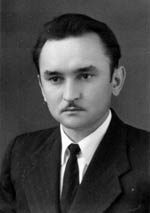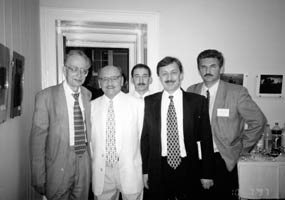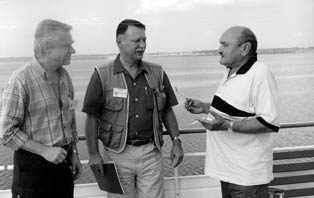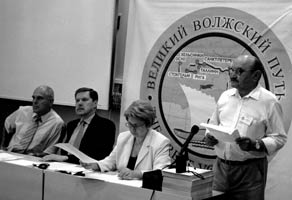Mirkasim Abdulakhatovich Usmanov
.jpg)
BRIEF DESCRIPTION OF SCIENTIFIC, PEDAGOGICAL AND PUBLIC ACTIVITY
The study of the centuries-old history of the Tatar people in modern times is inseparably connected to the name of the academician of the Academy of Sciences of the Republic of Tatarstan, Mirkasym Usmanov. From over forty-five years of research activity, he wrote a number of works that enriched significantly both the source base and the study of concrete historical problems of history and the study of literature and culture of the Tatar people over a long historical period between the 13th to early 20th centuries.
The life of Mirkasym Usmanov is different from biographies of the majority of his contemporary colleagues.
He was born on May 31, 1934, in the town of Kulja (West China, Xianjiang province) to the family of an office worker. The Usmanov family traces its roots to an ancient settlement named Bolshoi Menger of the present-day Atninsky district of the Republic of Tatarstan. As early as the 1920s of the 19th century his ancestors moved, just like many other Tatars suffering from lack of land, to the territory of contemporary Kazakhstan to engage in farming, beekeeping and trade. In 1917, at the time of great social upheaval, the Usmanov family decided to resettle, “until better days,” and moved to Kulja, which was a Russian settlement. After the revolution, when the frontier was closed, the Usmanovs remained in China, though preserving, as many others, their Russian, and then Soviet, citizenship.
Mirkasym Usmanov got his primary education in the Tatar school in Kulja, which he enrolled in 1941, and later he studied in the Russian Gymnasium of Kulja. Their schoolbooks were mainly published in Kazan and Moscow. At the same time, the study process of the Tatar school in Kulja had some peculiar features that were absent in Soviet schools. The pupils of the Tatar school in Kulja were acquiring the skills of writing and reading on the basis of both Arabic and Cyrillic scripts. This fact provided an opportunity to study numerous editions published in the pre-revolutionary period in the Tatar language based on the Arabic script. Such books were available in the school and private libraries.
His life in the multi-language environment helped him to master the fundamentals of the kindred Turkic languages: Kazakh, Uigur, Kyrgyz, and Uzbek. All that had later favourably influenced his professional activity as a historian, specialist in source study, and translator. For example, the Tatar readers first learned the works of the world famous Kyrgyz writer Chingiz Aitmatov owing to translations by Mirkasym Usmanov. It should also be said that every year in his childhood and youth Mirkasym had to move to the mountains that surrounded his native town with his parents where he plunged into the everyday life of the local people who still preserved the birthmarks of earlier social relations often described in historical science as feudal. Fishing on rapid mountain rivers, hunting mountain goats and marals in deep ravines and depths of forests, life in yurts, participation in the folk merry-makings of the nomads, horse races - all that had been later reflected on the pages of his first book, Kiyek Sukmaklarynda (On the Wild Paths: Notes of a Hunter), published in 1966 in Kazan. That edition can be considered a farewell to the bright and unforgettable pages of his childish and youthful life.
However, his youthful impressions also included events of another kind. In autumn of 1941, the local people of Xianjiang started the national liberation struggle against the rotten regime of Kuomintang. Street fighting took place in the town. As a result, three western parts of the Xianjiang province formed a state called, “Free (later substituted by ‘Revolutionary’) Eastern Turkestan.” The state existed as a sovereign unrecognised state until 1951. After the victory of the communist revolution in China, it voluntarily joined the Peoples’ Republic of China.
From 1944 to 1951, many local people took interest in socialist ideas. In the early 1950s many people thought more and more about coming back to their motherland. In 1955, the Usmanov family returned to the USSR (to Kazakhstan).
From 1955 to 1958, Mirkasym worked as a worker at the Sary-Bulak soviet farm, sugar plant and district committee of DOSAAF (Voluntary Society for Cooperation with the Army, Air Force and Navy) of the Kirovsky district of Taldy-Kurgan Oblast, and later at a film studio in Alma-Ata. In the same period, after graduation from the school for working youth in the Kirovo settlement of the Taldy-Kurgan Oblast of Kazakhstan, he got a graduation certificate of the Soviet type.
It was only natural that he longed to come to the motherland of his ancestors, to the old university city of Kazan. From 1958 to 1963, Mirkasym Usmanov studied at Kazan State University, first at the Department of Tatar Philology and then, following three years of study, he was moved up to the Section of History of the Department of History and Philology, where he specialised in source study of history in the Chair of History of the USSR. Over the period of his study at the University he took an active part in the students’ research activities, participating in work of dialectological and archaeological expeditions. Due to his participation in the exhibition of students’ works he was awarded the medal of VDNKH (Exhibition of Achievements of the National Economy of the USSR).
After finishing his studies he got a job in the Chair of History of the USSR. From 1964 to 1967, he was a post-graduate student. In 1968, he defended his Candidate of Sciences thesis, titled, “Tatar Narrative Sources of the 17th-18th Centuries in Their Peculiarity.” Starting from 1967, he worked as a teacher of the Chair of History of the USSR. In 1981, he defended his Doctor of Sciences thesis, titled, “Granted Acts of Ulus Juchi of the 14th–16th Centuries.” Since 1982, he became a professor and head of the Chair of History of the USSR of the pre-Soviet period; starting from 1989, he worked as head of the Chair of History of the Tatar People that he created at the newly established Department of Tatar Philology, History and Oriental Languages. At the same time, in 1988, he became the head of the Archaeographic Research Laboratory of Kazan State University that was set up by him. In the period between 1985 and 1991, he held the position of a prorector for studies at Kazan State University.
The teaching activity of Mirkasym Usmanov included, along with courses of lectures within traditional disciplines, the development of new courses concerning the source study of the history of the peoples of the Volga and pre-Ural regions, and about Old-Tatar palaeography. Over the past few years he had been teaching a special course about the history of the Turkic peoples and states of Eurasia. From 1968 to 198, he headed the specialisation in the history of Tatarstan.
The main field of his research activity was the study of written sources in Turkic languages based on Arabic script related to the history and literature of the Turkic-speaking peoples of the Volga and pre-Ural regions of the 13th to early 20th centuries. A special place in his research activity belonged to archaeographic research: he arranged and held expeditions to identify and collect from the Tatar population specimens of literature in oriental languages and studied them. The first of such expeditions was arranged on the initiative of Mirkasym Usmanov at Kazan State University in 1963. That expedition restored the rich traditions of the Kazan school of Oriental Studies in the field of collection and study of specimens of literature in oriental languages. From 1964 to 1989, Mirkasym Usmanov was a scientific head and permanent participant of the regular archaeographic expeditions of Kazan State University that conducted their research in many parts of the country, starting from Kostroma and the Kasimov, “Krai,” in the region near Moscow west of Irkutsk Oblast in the East, from Perm and Vyatka in the North, to Orenburg and Astrakhan in the South. From 1963 to 1986, he annually went into the field and took a direct part in the collection of manuscripts from the population. The survey, which was conducted in over 850 Tatar settlements in five autonomous republics and fifteen oblasts of the Russian Federation, brought more than nine-thousand manuscripts and some one and a half thousand rare old-printed editions in different oriental languages. That made it possible to increase the oriental stock of the Department of Manuscripts and Rare Books of the Scientific Library of Kazan State University almost two times. The archaeographic expedition continues to work successfully today.
The collected manuscripts include works from the 7th to mid-20th centuries (starting from copies of the Quran, to works created in the last period of using the Arabic script by the Tatars). These manuscripts include copies of works about Islamic jurisprudence, oriental philology, and the history of Islam, agiography, astronomy, mathematics, and geography. The manuscripts about belles-lettres and folklore, and historical study of local lore and private acts form a special group of manuscripts. The book, In the Tracks of Manuscripts: Notes of an Archaeographer (Kazan, 1984 and 1994), was dedicated to the description of the process of the collection of manuscripts from the population and revealing their subject matter and was highly appreciated both in the local and central press.
Mirkasym Usmanov carried out a significant work to identify and bring into scientific circulation the written sources on history and literature of the Tatar people in archives and libraries of different cities of the former USSR (Kazan, Alma-Ata, Kiev, Moscow, Orenburg, St.-Petersburg, Simferopol, Tashkent, Tomsk, Ufa, etc.). Relying on the results of scientific research he wrote and published the fundamental works concerning source study of the history of the Turkic-speaking peoples of the Volga and pre-Ural regions, such as, for example, Tatar Historical Sources of the 17th–18th Centuries (Kazan, 1972) and Granted Acts of Ulus Juchi from the 14th–16th Centuries (Kazan, 1979). The rich source base and validity of conclusions were duly appreciated in the comments and reviews of scientists from Kazan, Moscow, Leningrad, Baku, Tbilisi, Ankara, etc.
Under his leadership, with his active personal participation, a collection of Tatar documents from the time of the Peasants War of 1773-1775 was prepared and published that made a significant contribution to the study of the history of the people’s liberation movement in the 18th century. The documents were poorly studied before that (in all 188 pages) and originate from the camp of rebellions and exist as both originals written in Arabic script and copies translated into Russian. As a result, a number of sources about the history of the multinational peasants’ war, spearheaded by Yemelyan Pugachev, have been brought into scientific circulation.
Based on little-known sources, Mirkasym Usmanov studied and described in a new way the activity and heritage of such outstanding Tatar enlighteners of the 19th century as Shigabutdin Marjani, Khusain Faizkhanov, and Rizaetdin Fakhreddin.
The creative laboratory of the scientist is characterised by a systematised approach to research and a purposefulness when searching for new historical sources, which is confirmed by the example of finding a number of previously unknown or little-known items. Thus, it has been long thought that the Tatars did not have in their everyday life a ritual song titled, “Yar-Yar,” typical for a number of Turkic-speaking peoples of the CIS. However, following the targeted research that took several decades, Mirkasym Usmanov found several copies of this song among the people living in the Volga and pre-Ural regions and introduced several versions of the song to the scientific and literary community.
The text of the epic work titled, “Tulyak and Su-Slu,” was found by the archaeographic expedition in 1969. Prior, students of the folklore of Tatarstan had no written text of this medieval period at their disposal. Based on the acquired copy, and with the use of other versions, the scientist carried out a comprehensive study of this work.
From 1978 to 1979, while editing and publishing a book by Gabdurakhman Tagirjanov, a professor of Leningrad University, Mirkasym Usmanov took notice of information that the library of the Iranian Senate kept a copy of a work on pharmacology written by a Boulgar scientist of the early 13th century, Tajaddin ibn Yunus al-Bulgari, titled, At-Tiryak al-Kabir. However, it was impossible at that time for a number of obvious reasons, to obtain a copy of that valuable manuscript. It was only in late 1996 that the scientist, together with an official delegation of the Republic of Tatarstan, got an opportunity to visit Iran and received a copy of the manuscript owing to assistance of the presidents of the Republic of Tatarstan and Iran. That copy was later published as a separate book. Thus, the most valuable source for the study of the history and culture of the peoples of the Volga Boulgaria of the pre-Mongol period was brought to scientific circulation.
In the middle and third quarter of the past century it was fashionable, and even obligatory in the USSR, to take every chance to criticise and find faults with so-called Jadidism, its ideologists and representatives of the national liberation movement in general. Many authors showed interest in and even used such chances. Mirkasym Usmanov managed to avoid such opportunities. He had no need to edit himself or, what is more, to hide his previous publications and reports or feel embarrassment for them.
Popularising the achievements of science or drawing the attention of the public to the still unsolved issues of history, Mirkasym Usmanov paid due attention to popular scientific and public materials concerning pages of the periodic press (a sample of such publications in the Tatar language is represented in the book, From the Past to the Future (Kazan, 1990).
The scientist paid great attention to the publication of popular scientific articles and books about history written in his mother tongue for youth, in which he tells his young readers in an understandable way about the past and culture of his people. In this vein we can mention such books as, Mysterious Balbal (Kazan, 1973), or, Travel to the Country of Mountains and Valleys (Kazan, 1977). In 1984, these works were published in one volume.
In all, Professor Usmanov published a large number of scientific works (over 450 titles), including eleven books (monographs, collections). Together with his foreign colleagues, he published texts of Tatar written sources in Hungary and Germany. Also, over thirty books by other researchers were published under his editorship or were adapted by him. He published a number of articles in scientific journals and collections issued in Germany, USA, Taiwan, Turkey, France, South Korea, etc.
He took part in many regional, All-Union (USSR) and international scientific conferences and symposiums (Poland, Hungary, Turkey, USA, and Germany).
A number of Candidate of Sciences theses were defended under the direction of Mirkasym Usmanov based on written sources using Arabic script.
While a prorector at Kazan State University, Mirkasym Usmanov took an active part in the establishment of new divisions of the University: an archaeographic research laboratory for collection, study and publication of written sources, several chairs of history and philology at the Department of Tatar History, Philology and Oriental Languages (opened in 1989), and the Department of Ecology. He took an active part in the creation of the basis for restoration of the University’s divisions engaged in oriental studies, etc. He took part in the establishment of contacts between Kazan State University and a number of foreign universities (Hungary, Germany, China, and Turkey).
Mirkasym Usmanov was a member of two Doctors, and five Candidates, Councils: Kazan State University, University of Culture, Institute for History of the Academy of Sciences of Tatarstan, the National Library, and the National Museum of the Republic of Tatarstan. He is also a member of the Archaeographic Commission of the Russian Academy of Sciences, Union of Writers and editorial boards of a number of journals, including one international magazine, Central Asian Survey of London. Academician Usmanov was among the founders of the Academy of Sciences of the Republic of Tatarstan. He was a member of the organising committee for holding of the 35th International Congress of Orientalists (Budapest, 1997). In October 1997, the first All-Russian Organisational Congress of Orientalists of Russia elected Mirkasym Usmanov the President of the Society of Orientalists of the Russian Academy of Scientists for a two-year period. From 1998 to 2000, three international conferences dedicated to the source study of the history of the Ulus Juchi (Golden Horde), historical geography of the Middle-Volga region, and the origin and development of cities in our region were organised and held in Kazan with his active participation and under his scientific direction. He took an active role in organising and holding a multi-stage conference called, “The Great Volga Route.” He was also a member of the republic’s organising committee for the celebration of Kazan’s 1000th Anniversary.
An honoured scientist of Tatarstan and an honoured employee of institutions of higher education of the Russian Federation, Mirkasym Usmanov took part in the revival of social life in his republic. From 1989 till 2010 he was a chairman of the Jien Fund, whose purpose is to contribute to the revival and development of Tatar language and culture, where he participated in publishing activity. For example, in 1990 and 1991 he republished historical works by Mikhail Khudyakov, Karl Fuchs, Ismail Gasprinsky and a number of other books. Over the past few years he has published, together with his followers, a series of documentary collections about the outstanding representatives of Tatar culture.
Mirkasym Usmanov vigorously continued his research and organisational work in the field of identification, study and publication of written sources and reference manuals on Old-Tatar printed editions, actively involving the staff of the chair, archaeographic laboratory and students, until his passing in 2010. At the same time, he studied the history of separate Tatar communities within and beyond the Russian Empire in the period before 1917.




Last updated: 9 February 2021, 18:13